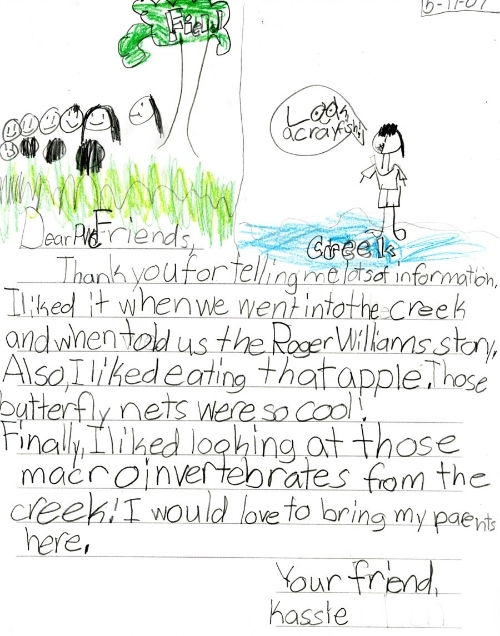Field & Stream Communities Day- Grades 2 & 3
One of our most popular programs! Two lessons in one full day at the Conservancy!
Exploring Field Communities:
Out of our “magic bag” come the four abiotic essentials needed to support life in the field community. With these in tow we take off on a consumer hunt, identify the producers, “Get Down!” with the decomposers, and make mini-communities of our own! A great opportunity to support classroom learning "in the field!"
Introduction to Stream Communities:
Travel to the East Branch Creek and uncover the secrets of life in a stream community. How does the energy needed to sustain life travel through this community? Good question! We’ll find out as we meet a variety of animals, get our boots wet, search for animal homes, and investigate this remarkable watery environment!
Fee: At the Conservancy : $16 per student ($160 minimum fee) for both programs in a full day at the Conservancy or $10 per student for one of the programs in a half day at the Conservancy.
For more information or for reservations contact: PWC Education Department at education@perkiomenwatershed.org
What the teachers are saying:
Wow! We were blown away by our experience at the Perkiomen Watershed Conservancy! Your enthusiasm for working with children is contagious. The Field and Stream experiences were quite powerful. The children and parents were so engaged in each of the activities planned!
- 2nd Grade Teachers, Souderton Charter School Collaborative
We thought this was an awesome field trip experience. It tied in perfectly with our science curriculum. Everyone there was extremely knowledgeable and the students thoroughly enjoyed all of the activities. Excellent job!
- 2nd Grade Teacher, Schwenksville Elementary
Thank you so much for this valuable experience. I am not the most nature-friendly person, but I thoroughly enjoyed every minute! I have a new respect for the outdoors!
- 2nd Grade Teacher, Washington Elementary
NEW STEELS Standards ccoverdd by this lesson include:
3.1.2.A Plan and conduct an investigation to determine if plants need sunlight and water to grow.
3.1.3.A Develop models to describe that organisms have unique and diverse life cycles but all have in common birth, growth, reproduction, and death.
3.1.3.G Construct an argument with evidence that in a particular habitat some organisms can survive well, some survive less well, and some cannot survive at all.
k 3.1.2.C Make observations of plants and animals to compare the diversity of life in different habitats
3.1.3.H Make a claim supported by evidence about the merit of a solution to a problem caused when the environment changes and the types of plants and animals that live there may change.
3.2.2.A Plan and conduct an investigation to describe and classify different kinds of materials by their observable properties. 3.2.2.B Analyze data obtained from testing different materials to determine which materials have the properties that are best suited for an intended purpose.
3.3.2.A Use information from several sources to provide evidence that Earth events can occur quickly or slowly.
3.3.2.A Use information from several sources to provide evidence that Earth events can occur quickly or slowly.
k 3.3.2.B Compare multiple solutions designed to slow or prevent wind or water from changing the shape of the land.
3.3.4.B Make observations and/or measurements to provide evidence of the effects of weathering or the rate of erosion by water, ice, wind, or vegetation.
3.3.5.C Develop a model using an example to describe ways the geosphere, biosphere, hydrosphere, and/or atmosphere interact
k 3.3.2.D Obtain information to identify where water is found on Earth and that it can be solid or liquid.
3.4.3-5.A Analyze how living organisms, including humans, affect the environment in which they live, and how their environment affects them
3.4.K-2.C Explain ways that places differ in their physical characteristics, their meaning, and their value and/or importance
3.4.3-5.D Develop a model to demonstrate how local environmental issues are connected to larger local environment and human systems.
3.4.3-5.E Construct an argument to support whether action is needed on a selected environmental issue and propose possible solutions.
3.4.K-2.D Plan and carry out an investigation to address an issue in the local environment and community
3.4.3-5.F Critique ways that people depend on and change the environment.
3.4.3-5.G Investigate how perspectives over the use of resources and the development of technology have changed over time and resulted in conflict over the development of societies and nations.
3.5.K-2.A Identify and use everyday symbols
3.5.K-2.B Describe qualities of everyday products
3.5.K-2.G Explain the tools and techniques that people use to help them do things.
3.5.K-2.I Compare simple technologies to evaluate their impacts.
Current PDE Academic Standards covered by this lesson include:
3.1.2.A9 - Distinguish between scientific fact and opinion. • Ask questions about objects, organisms, and events. • Understand that all scientific investigations involve asking and answering questions and comparing the answer with what is already known. • Plan and conduct a simple investigation and understand that different questions require different kinds of investigations. • Use simple equipment (tools and other technologies) to gather data and understand that this allows scientists to collect more information than relying only on their senses to gather information. • Use data/evidence to construct explanations and understand that scientists develop explanations based on their evidence and compare them with their current scientific knowledge. • Communicate procedures and explanations giving priority to evidence and understanding that scientists make their results public, describe their investigations so they can be reproduced, and review and ask questions about the work of other scientists.
3.1.1.A1 - Categorize living and nonliving things by external characteristics.
3.1.1.A2 - Investigate the dependence of living things on the sun’s energy, water, food/nutrients, air, living space, and shelter.
3.2.1.B6 - ENERGY Recognize that light from the sun is an important source of energy for living and nonliving systems and some source of energy is needed for all organisms to stay alive and grow.
4.2.1.A - Explain the path water takes as it moves through the water cycle.3.1.2.C2 - Explain that living things can only survive if their needs are being met.
3.2.2.B6 - ENERGY Recognize that light from the sun is an important source of energy for living and nonliving systems and some source of energy is needed for all organisms to stay alive and grow.
4.1.2.A - Describe how a plant or an animal is dependent on living and nonliving things in an aquatic habitat.
4.1.2.C - Identify sources of energy in an aquatic habitat.
4.1.2.D - Identify differences in living things (color, shape, size, etc.) and describe how adaptations are important for survival.
4.1.2.E - Identify how living things survive changes in their environment.
4.2.2.C - Identify and describe the basic needs of plants and animals in an aquatic ecosystem.
4.3.2.A - Describe the jobs/hobbies people have in the community that relate to natural resources.
4.4.2.A - Identify agriculture as a living system and that food and fiber originate from plants and animals.
4.4.2.C - Examine life cycles of plants and animals in an aquatic habitat.
4.5.2.C - Identify how people can reduce pollution.
3.1.3.A1- Describe characteristics of living things that help to identify and classify them.
3.1.3.A2 - Describe the basic needs of living things and their dependence on light, food, air, water, and shelter.
3.1.3.A3 - Illustrate how plants and animals go through predictable life cycles that include birth, growth, development, reproduction, and death.
3.1.3.C1 -Recognize that many plants and animals can survive harsh environments because of seasonal behaviors (e.g. hibernation, migration, trees shedding leaves).
3.2.3.B6 - ENERGY Recognize that light from the sun is an important source of energy for living and nonliving systems and some source of energy is needed for all organisms to stay alive and grow.
4.1.3.A - Differentiate between the living and non-living components in an environment.
4.1.3.D - Identify organisms that are dependent on one another in a given ecosystem.
4.2.3.A - Define the term watershed. Identify the watersheds in which you reside.
4.2.3.B - Identify plants and animals found in a wetland.
4.2.3.C - Identify plants and animals that live in lakes, ponds, streams, and wetlands.
4.5.3.A - Identify resources humans take from the environment for their survival.
4.5.3.C - Identify different types of pollution and their sources.








